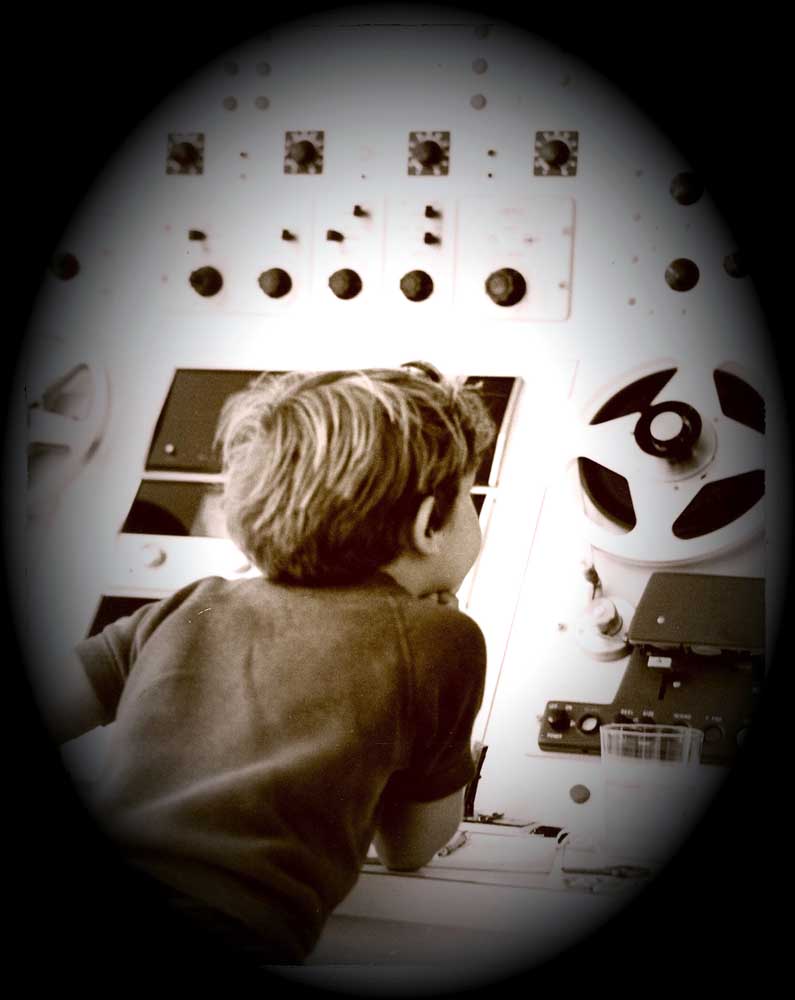Rogue Spotlight: Musician turned travel agent finds harmony as sound engineer
Published 12:00 am Tuesday, June 13, 2023

- Sean McCoy, at the age of 4, is captivated by the soundboard in a studio of one of his jazz pianist mother's friends. He now owns Oregon Sound Recording in Central Point.
Sean McCoy studied music in college, pursued a career as a trumpet player and composer, became a travel agent after disappointing results in the music business, and finally emerged as a thriving sound engineer with his own state-of-the-art studio.
The story is a testament to the potential for reinvention.
He said he was young, impatient and burned out chasing the dream but, eventually, “all the dominoes fell into place.”
McCoy’s business, Oregon Sound Recording (OSR), is located in Central Point. He works with Rogue Valley businesses, artists and organizations as well as with clients far and wide.
OSR offers film and commercial scoring, music recording and mixing, music mastering, voiceover recording, audio post-production, automated dialogue replacement recording (where an actor dubs their voice in a quiet setting while watching a looped scene of themselves), transfers and enhancements, and duplication.
His work involves a wide range of projects.
“In 2021, I did audio post and wrote the score for a documentary, ‘The Longest Month,’ that focused on the experience of helicopter pilots in Iraq during the surge there,” he said.
In 2022, he recorded and mixed the CD, “Sempiternity,” for Peter Anastos, a jazz trumpeter and flugelhorn player.
“I’m currently working on an opera by composer Ethan Gane-Morse,” he said. “The work, ‘Dreams Have No Borders,’ involves recording three world-class singers and a string quartet at the Camelot Theatre (in Talent). The project will be released as a film later this year.”
He also is currently working on the second season of a TV show called “The Chosen Unveiled,” to air on Trinity Broadcasting Network in June. It’s a companion series to the popular show, “The Chosen.”
Local entities he’s worked with include Bruce Campbell, Kathy Zavada, Rogue Valley Symphony, Southern Oregon Repertory Singers, Rogue Valley Chorale, SOU music department, OSF, Southern Oregon PBS, KOBI, Harry & David, and Leslie Kendall, to name a few; and most of the area’s advertising agencies.
McCoy, born in Enid, Oklahoma, was whisked out of there while still an infant by his professional jazz pianist mother, Patti McCoy (stage name, Pat Moran).
“I spent my first eight years living in various cities where she performed — Los Angeles, Denver, Minneapolis, Sausalito, Lake Tahoe,” he said. “She married my adoptive father when I was 8, and I spent the rest of my youth in Ashland.”
His mother had a flourishing career in the 1950s and ’60s, continuing to perform, write, record and teach after the family moved to Oregon. “So there was always music in the house,” he said.
His biological father, whom he never knew, was a successful jazz pianist and music director. “And my adoptive father is a very creative writer of prose,” he said. “During his years as a DJ at the old KYJC, I used to experiment with audio in their production room while he was working. One weird electronic ditty I put together even got him an ‘A’ in his music appreciation class. An early sign of things to come, I guess.”
It was his adoptive father who instigated the move to the Rogue Valley in 1965.
“He had roots here, and his mother was living here,” McCoy said. “So when he said he wanted to move here and go to Southern Oregon College, my mother jumped at the chance to leave the music scene she had grown weary of.”
With McCoy’s passion for music, he showed some early promise, learning Bach Two-Part Inventions by ear and tinkering with writing at the piano.
“I started playing trumpet at 11 and wrote my first arrangement for our sixth-grade talent show. In ninth grade, I started getting interested in jazz. In addition to playing trumpet, I wrote original compositions for our jazz band throughout my years at Ashland High.”
He was all set to attend SOU in order to study with David Caffey, a composer, arranger and conductor. When Caffey left for a job in Texas, McCoy went to the University of Oregon instead. He spent three years there, then studied at California State, Long Beach, and Cal State, Northridge, before pursuing his career.
His wife, Theresa, is also an accomplished musician. She plays timpani for Rogue Valley Symphony and percussion with various bands and ensembles in the area.
“She was doing well musically in L.A.,” he said, “and many within her group of friends were involved with the rapidly changing technology. MIDI (Musical Instrument Digital Interface), synthesizers, drum machines and nascent home recording allowed one person to do what had previously always required a group of musicians.”
Working as a travel agent at the time, he found his interest in music revived by his wife’s “sneaky” exposure to her musician friends.
At the time, his father owned an ad agency, McCoy Advertising in Medford. He had his own sound studio in the office and offered Sean a job and training in studio technology if he wanted to move back to Oregon. He said yes.
“We ultimately renamed that studio Oregon Sound Recording, and I took it independent about two years later,” he said.
Most captivating to McCoy about the business is the magic that can be created in a sound studio.
“The recording process involves enhanced reality,” he said, “meaning that mics and other parts of the recording path don’t hear or reproduce sound the same way we hear it in the real world.”
He added, “Those big and beefy sounds or intimate and whispery voices we hear on trailers and commercials can happen only in a recording studio.”
Secondly, he says, the Beatles and many other highly innovative artists have discovered over the years that the studio is where “creative dreams” can be realized.
“The stacking of voices, horns, strings, guitars, etc., requires multichannel recording. It obviously would have been impossible for Enya to sing along with herself 250 times in a live concert.”
The experimental manipulation of sounds involves trial and error, and McCoy finds the processes and possibilities compelling and fascinating.
A number of projects stand out as most memorable.
“I’ve had the opportunity to write a couple of film scores, which is a dream come true for this composer,” he said. “There was also an album I produced for my mother, which we recorded mostly at O’Henry’s, a top-notch studio in L.A. with awesome musicians.”
But if he had to pick one project that was completed entirely here in the Rogue Valley, it would be working with The Oregon Trio.
“The trio was here creating music for an OSF production of ‘A Midsummer Night’s Dream.’ I had been a big fan of theirs since college, so getting to work with them was pretty trippy.”
He felt privileged to be in the rarefied air of the creative process of such a talented team.
“Coincidentally, my work with Paul McCandless, the oboist for the trio on that project, led to my including him on two songs on my mother’s project, as he happened to be back here that same year, doing another project with OSF.”
Another recent project that was particularly gratifying was working with former Ashland resident James Twyman on a video to promote Red Cross donations for Ukraine, with the music adapted from Peter Gabriel’s “Red Rain.” The arrangement and mixing were all McCoy’s. And other than the performers seen playing in the video, McCoy played everything else. The moving video can be seen on YouTube at youtube.com/watch?v=QItwfNonbBI. Or you can search YouTube for “Red Rain Over Ukraine.”
His audio post-production work is where he creates more magic. It ensures that music and dialogue are clean and consistent throughout.
It might even involve taking a word or phrase from an unused take and massaging it, in sync, into the finished project to clean up a bad spot.
“I also remove as many distracting pops, clicks or other noises, either manually or using dedicated processes,” he said. “Another major part of dialogue work is reducing background noise.”
He says technology in noise reduction has advanced greatly in recent years, now incorporating a form of AI (artificial intelligence). Beyond that, his job is to balance the voices with music and sound effects.
“This is done mostly by ear,” he said.
He enjoys his work and doesn’t plan to retire until he’s “either deaf or dead.”
The reward is helping creators realize their vision.
To learn more about Oregon Sound Recording and to listen to samples of his work, go to oregonsound.com.






